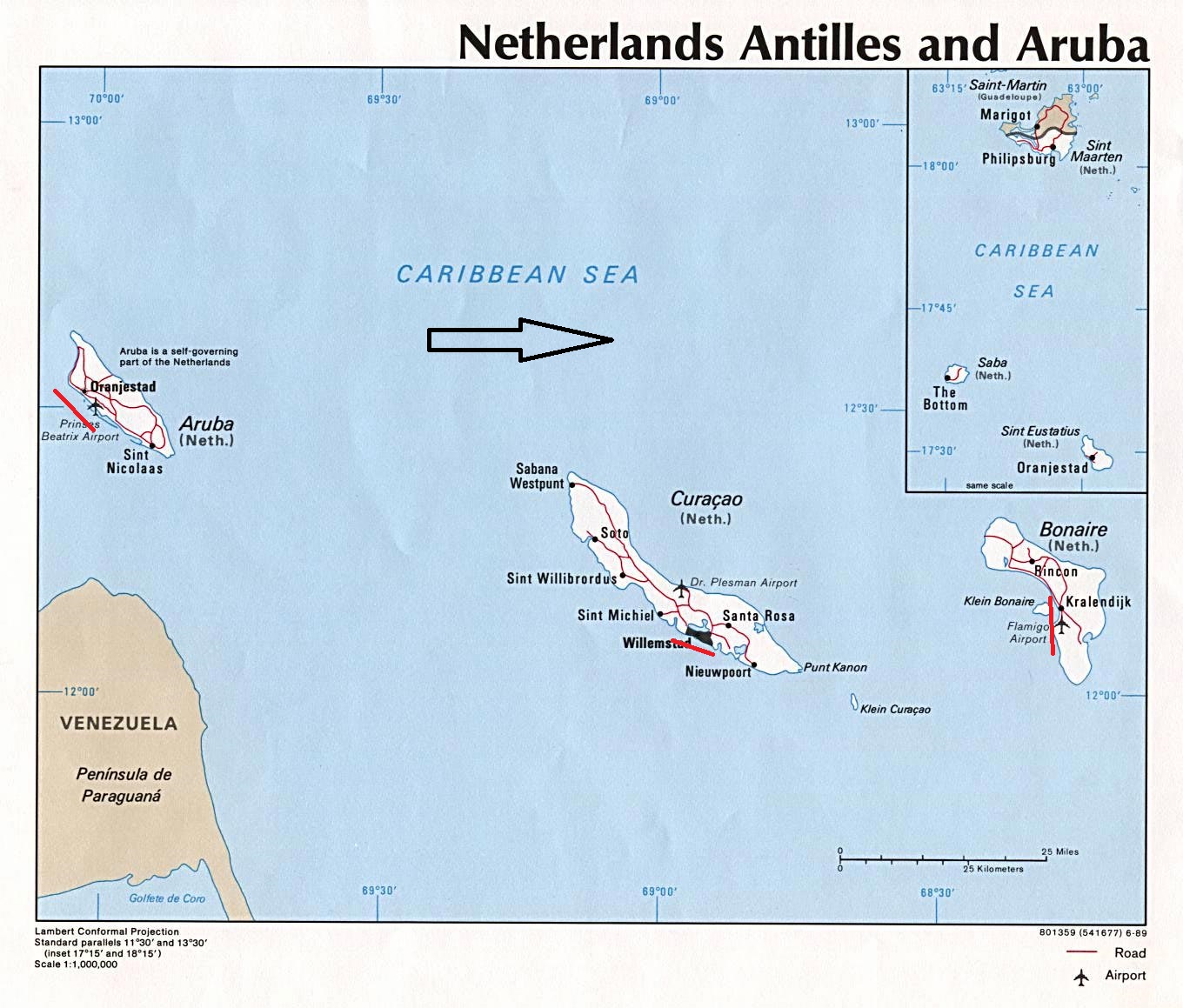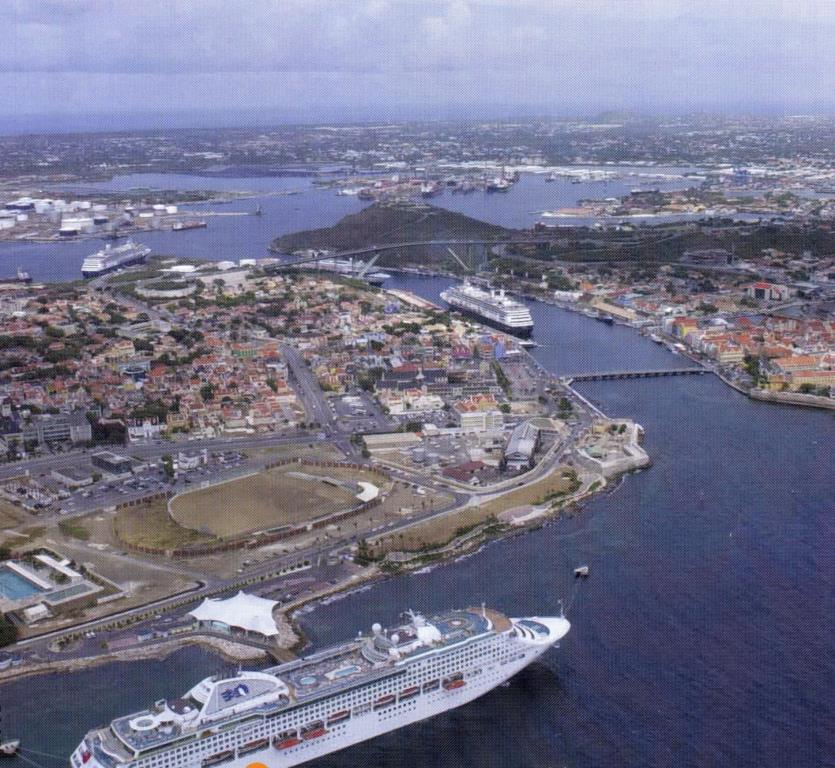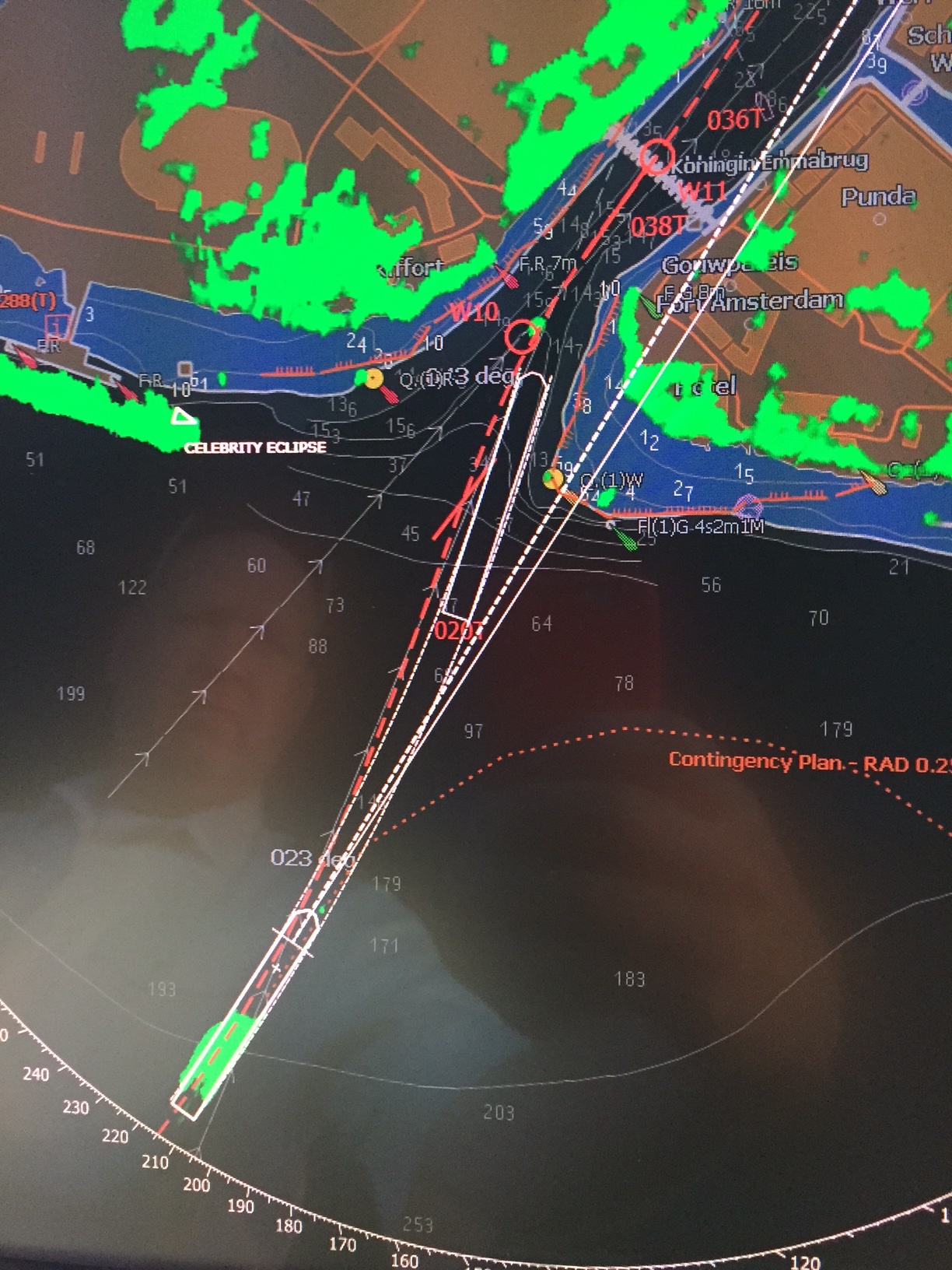After a very windy arrival yesterday we docked at Oranjestad Aruba. It was so windy that the captain had to abort the first approach as the wind was gusting up too much. So the ship made a full circle and lined up again. Then the wind dropped suddenly, giving the Zuiderdam the chance to sail in through the narrow western entrance and dock at the C terminal, which is the closest one to the Town. Aruba is always a windy affair as the island is tilted along the Venezuelan coast under a slight North West angle. This means that the Easterly Trade winds do not blow in line with the docks on the island. Wind under a large angle will push the ship towards the reef. A reef we really like as it creates a natural breakwater for the port and keeps the swell away.
But if the Trade Wind is stronger than normal and more under an angle then it can get tricky at the entrance. Luckily for us yesterday, the Trade wind was only under a slight angle to the docks and abated suddenly from 35 knots down to 25 knots and we were in business. Getting out was less of a problem, as we sailed at 22.30, and then after a few hours of darkness over the whole Caribbean Sea the wind will ease off, as the hot sun does help to create more turbulence and difference in pressure.

The lower Dutch Caribbean Islands, Aruba, Curacao, Bonaire. The prevailing Trade Wind is almost from due East. Please note in red the line up of the docks. Aruba is not great. Curacao outside is good, inside not so good. Bonaire is 90o on the trade wind direction and thus we are there at sunrise before the wind really starts to blow.
From Aruba to Curacao it is a slow boat affair sailing eastwards even if one leaves late. In the good old days when we had steamships we used to leave from here at midnight. Steamships burn nearly the same amount of fuel when going slow as when going fast, due to the fact that the oil is burned in boilers to generate steam. When docked, you can squeeze the boiler output to a low minimum but at sea when you need at least a certain speed that is much harder. So we stayed until midnight and then raced to the next port to dock as soon as we arrived. But when staying to midnight we found out that only the crew came back after 23.00 hrs. Hardly or no Guests stayed ashore that late. They all came back much earlier as the next day was a busy day again. Hence leaving after 22.30 has proven not to inconvenience the guests and with motor ships we can save fuel while sailing and at the same time open everything up on board for the Guests satisfaction.

Overview of the port of Willemstad Curacao. Below is the Mega Pier 1 were we docked today. Just inside the St.Anna baai at the Matthew dock is a Holland America Line ship, the Amsterdam or Rotterdam, under the bridge is a small Celebrity ship and past the bridge at the Hendrik dock is another Holland America Line ship, either the Volendam or the Zaandam. The S and R class have lower masts than the Zuiderdam so they can sail under the Juliana bridge and turn inside in the Schottegat.
In Willemstad, Curacao, they have constructed two Mega Piers for the Mega Cruise ships as it is very hard for them to dock in downtown, St. Anna Baai. The entrance to the port is on a 90o angle with the prevailing Trade Winds and thus making it very difficult for an “Apartment of the Seas” to avoid drifting onto the west harbor entrance when coming in. For the larger cruise ships there is also no plan B for coming in faster (the faster you go, the less influence the wind has on the ship), sail through the entrance, turn in the Schottegat and then come back to dock from the other side, while in the shelter of the hills on the North Side.
Depending on what ships are in and how big, the Zuiderdam docks at Mega Pier 1, 2. If those berths are already occupied by larger ships, then she has to go to the old port and dock nose in. As we do not fit under the bridge we cannot sail in and turn around in the inner harbor in the back called the Schottegat. Then on departure it means backing out. Sounds not too difficult but in front of the harbor entrance runs a cross current, which can reach velocities of up to 4 knots. (That is an equivalent of 40 knots of wind hitting the ship full on the beam. For that cross current you prefer to make speed before you come into it, but going astern does not give time to gather momentum. Luckily with the Azipod system, ships have so much power that it is do-able. But that does not mean that it is a captain’s favorite maneuver.

This is sailing, into the harbor. Note the way the projected ships movements curves. There is the line with the arrows right in the middle, but the ship has to sail straight for the shore and then gauge the current strength correctly to push it exactly into the opening. When going out it is the same. As soon as the stern comes out of the opening it will be pushed towards the west. So again you have “to angle” against the current to stay clear of everything.
At the mega pier there is a favorite maneuver. On departure we will conduct the”blow away maneuver”. We let go all the lines, the wind blows up off the dock, the current gets in between ship and dock and the ship nicely drifts away to deep water. Then the only thing one has to do is give a kick ahead and we are gone.
Tomorrow we have a day at sea while we are sailing to the Panama Canal. This is a 10 day cruise and thus there is no Cartagena. That will be next cruise again. The weather = read wind= is not supposed to change very much, so eventually when we come above the top of Colombia, the ship will come under the influence of the swell again that will just hit the ship ¾ on the stern. And then we will get this corkscrew motion again and there will be nothing we can do about it.

February 22, 2019 at 4:58 am
Hallo Kaptein; another historical HAL question if I may; who was the last HAL commodore? I understand the title/rank was given to the senior HAL captain at the time – I believe Commodore Coenraad Bouman was the take-out master for Rotterdam V, but not sure if he was also the last HAL commodore. Secondly; why did the line do away with the position/rank? Thanks very much in advance!
February 22, 2019 at 8:33 pm
Hallo Copper:
Yes indeed Captain Bouman was the commodore who took the ss Rotterdam (V) out. He was replaced by Commodore Kooijmans and he was replaced by the last commodore, Captain Auke de Jong. He retired in 1968 and the company then decided that the Commmodore title was not something that fitted in the future vision of cruising.
Why I do not know as other company’s still kept the title and they also went cruising. Those on the ships did not mind so much as the company did not always pick the most senior captain but on occasion the captain that was most liked in the office. Nowadays it would not work anymore anyway as we have junior captains on the largest ships and very senior ones on the smaller ships. So the days of the senior man, sailing the largest / senior ship are long gone.
Best regards
Captain Albert
February 24, 2019 at 12:17 am
Thanks for your in-depth response, Kaptein!
February 22, 2019 at 8:55 pm
Enjoyed the comments about docking at Willemstad, Curacao. I do remember going under the bridge and turning around my first cruise there, and was wondering why on recent HAL cruises we have only docked at the Mega Pier. On the Oosterdam in Dec 2016, we were at the Mega and Zuiderdam did the nose in and stern out which seemed rather awkward. Then back on the Veendam in 2017, we also docked at the Mega Pier as we were the only ship. It is more enjoyable to sail in and do the turn; guess I’ll have to pick a cruise when on a S or R class when the Mega Pier is full.